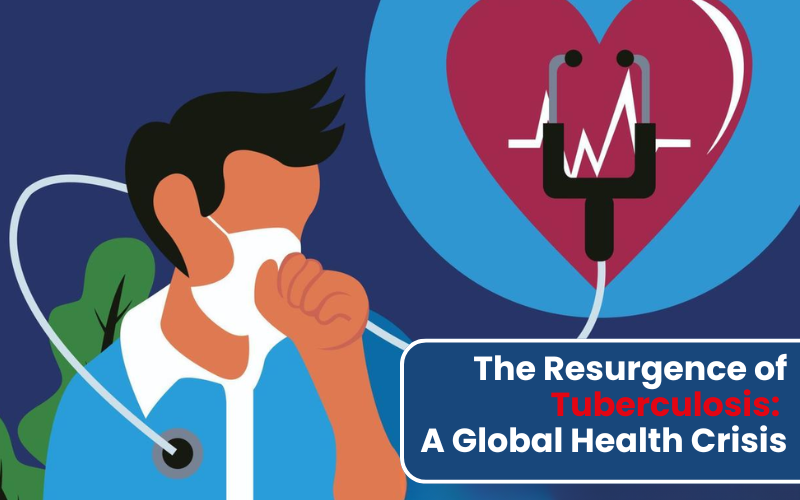Tuberculosis (TB), once on the decline, has alarmingly resurged as the world’s leading infectious disease killer. In 2023, approximately 8.2 million new TB cases were reported globally, marking the highest number since the World Health Organisation (WHO) began monitoring in 1995. In the same year, TB killed 1.25 million people worldwide.
UK Health Security Agency’s (UKHSA) most recent data on tuberculosis (TB) revealed a rise in reported numbers in England by 13% in 2024 (5,480) compared to 2023 (4,850). This signals a rebound to above the pre-COVID-19 numbers, despite significant progress towards a decline in TB over the last few decades.
The TB burden is disproportionately concentrated in 30 high-prevalence countries, with India, Indonesia, China, the Philippines, and Pakistan accounting for over half of all cases. Specifically, India alone contributes 26% of the global TB burden. Pakistan faces an estimated 518,000 to 611,000 new TB cases annually. Demographically, 55% of TB cases occur in men, 33% in women, and 12% in children and young adolescents.
A History of TB
Tuberculosis has been around for over 3 million years, with knowledge of the disease dating back to ancient Greece and Rome. In the early 20th century, TB was the top cause of death in the United States. Although significant progress was made in controlling the disease, a resurgence in cases has health officials puzzled.
For much of its history, TB was romanticized and thought to elevate artistic ability—it was often described as a blessing. Many famous artists, poets, and writers suffered from the disease, and it was thought that it formed a sort of exchange between life and art. “Consumption was believed to bring the creative powers to new levels,” John Green, author of Everything is Tuberculosis: The History and Persistence of Our Deadliest Infection, writes, “helping artists get in deeper touch with the spirit as their worldly bodies literally shrank away.” Symptoms of tuberculosis included pale skin, thinness, and sunken eyes, which Green points out, became “signals of beauty in Europe and the United States.” For women, TB was considered, as Charlotte Bronte writes, “a flattering malady.”
Causes and Symptoms
Tuberculosis is caused by the bacterium Mycobacterium tuberculosis. It mainly affects the lungs, but it can affect any part of the body, including lymph nodes (glands), bones and the brain, causing meningitis. It spreads through droplets in the air when an infected person coughs, sneezes, or talks. Symptoms include:
- Cough
- Fever
- Night sweats
- Weight loss
- Malaise
Why TB Remains Uncontrolled
Several factors contribute to the resurgence of TB:
- Drug resistance: Poor adherence to treatment and inadequate susceptibility testing have led to increased drug resistance.
- Weakened immune systems: People with HIV/AIDS and other immunocompromised individuals are more susceptible to TB.
- Global health disparities: TB cases are highest in Southeast Asia, Africa, and the Western Pacific, where access to healthcare is limited.
A significant obstacle in combating TB is inadequate funding. In 2023, global financial support for TB prevention and care reached only $5.7 billion, a mere 26% of the required $22 billion target. This shortfall hampers efforts to develop new diagnostics, treatments, and vaccines, with only 20% of the $5 billion annual research funding goal met in 2022.
Multidrug-resistant TB (MDR-TB) further complicates the situation. While treatment success rates have improved to 68%, only 44% of the estimated 400,000 individuals with MDR-TB received appropriate care in 2023. This resistance underscores the urgent need for enhanced funding and innovative treatment strategies.
Awareness, geographical access to healthcare services, language and cultural barriers, and lack of support to attend screening appointments can also contribute to lack of treatment. Patients may experience difficulties self-administering treatment and attending follow-up appointments. Consequently, 25% of individuals with TB and social risk factors do not complete treatment within the expected duration.
The economic burden of TB is profound, particularly in low- and middle-income countries, which bear 98% of the global TB load. Over half of TB-affected households in these regions face catastrophic costs, exceeding 20% of their annual income, to access necessary care. Contributing factors include undernutrition, HIV co-infection, alcohol use, smoking, and diabetes, all of which increase vulnerability to TB.
Protecting Ourselves
To prevent further spread, we can:
- Get tested: If you’re at risk, get tested for TB infection.
- Practice good ventilation: Ventilation can lower the concentration of airborne bacteria.
- Use protective gear: Healthcare workers should wear respirators when treating TB patients.
- Complete treatment: If diagnosed with TB, complete the full treatment course to prevent drug resistance and transmission.
- Vaccination: Vaccines can protect against TB, especially in high-risk areas.
Treatment and Cure
With the right health care and drugs, TB is treatable and preventable. Without treatment, it has a death rate of close to 50%. It’s curable with antibiotics, but treatment can last several months. A combination of medications, including isoniazid, rifampin, pyrazinamide, and ethambutol, is used to treat active TB. Latent TB can be treated with isoniazid or rifampin alone.
Treatment of active TB requires at least six months of uninterrupted therapy. Disruptions in treatment result in further spread of TB and the emergence of multidrug resistant TB, which requires additional drugs and more than nine months of treatment.
The fight against TB requires a collective effort. By understanding the disease, its causes, and its symptoms, we can work together to prevent further spread and ultimately bring TB under control.



